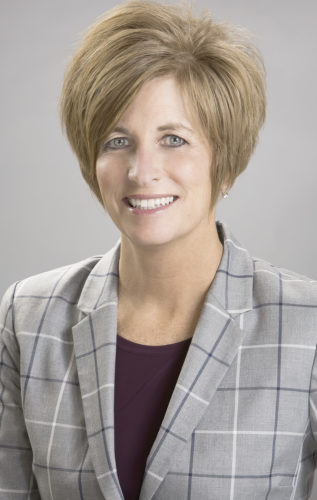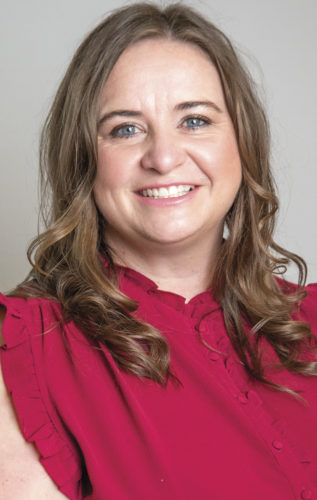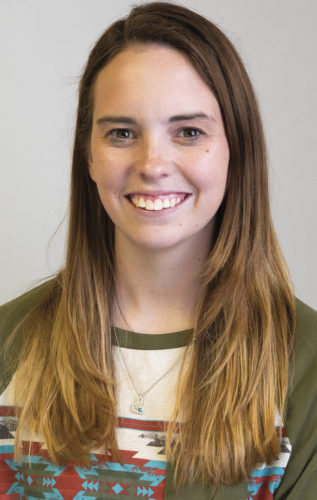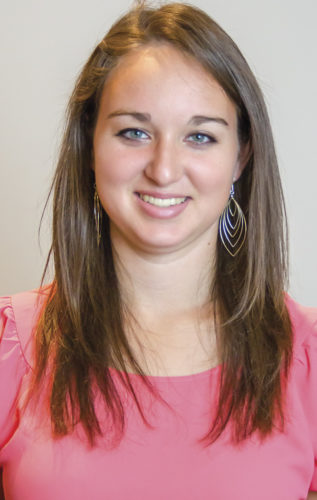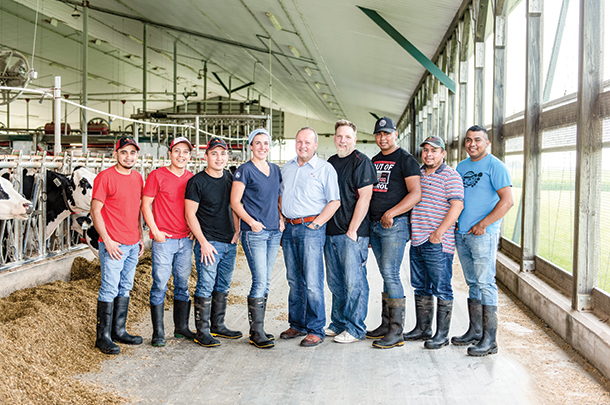 Protocols, a health and safety program, above-average wages and celebrating employee milestones are key to the retention of seven full-time, non-family employees at Hoenhorst Farms. The full-time team, pictured, from left to right: Alvaro, Vigler, Mauricio, Cox, Gerrit, Keith, Mario, Orlando, Omar. Photo courtesy of Semex.
Protocols, a health and safety program, above-average wages and celebrating employee milestones are key to the retention of seven full-time, non-family employees at Hoenhorst Farms. The full-time team, pictured, from left to right: Alvaro, Vigler, Mauricio, Cox, Gerrit, Keith, Mario, Orlando, Omar. Photo courtesy of Semex.8. Hoenhurst Farms multiplies its success with a methodical management approach
 Protocols, a health and safety program, above-average wages and celebrating employee milestones are key to the retention of seven full-time, non-family employees at Hoenhorst Farms. The full-time team, pictured, from left to right: Alvaro, Vigler, Mauricio, Cox, Gerrit, Keith, Mario, Orlando, Omar. Photo courtesy of Semex.
Protocols, a health and safety program, above-average wages and celebrating employee milestones are key to the retention of seven full-time, non-family employees at Hoenhorst Farms. The full-time team, pictured, from left to right: Alvaro, Vigler, Mauricio, Cox, Gerrit, Keith, Mario, Orlando, Omar. Photo courtesy of Semex.8. Hoenhurst Farms multiplies its success with a methodical management approach
Hoenhorst Farms in Innerkip, Ontario, milks 480 cows and is operated under the observant eye of fourth-generation dairy farmer Cox Wensink. Wensink is an engineer and product designer by trade but was drawn back to her family’s farm in 2013 after a successful career in management consulting.
When Wensink returned to the farm, she joined the team as a full-time herdsperson. Reflecting on her homecoming, Wensink says, “I had a lot of questions. I like numbers, I like Excel sheets, so I started translating the questions into numbers to help me better understand how the farm was doing.”
Today, Hoenhorst Farms monitors 100 key performance indicators (KPIs) across a variety of areas, like animal health, reproduction and finances. Wensink says all these indicators work together to help create a level of predictability on the farm. “The more accurately you’re monitoring, the more accurately you can predict where you’re going,” she says.
Based on your farm’s KPIs, name a target you’re currently working on and what steps you are taking to influence it.
"We always look at ways to improve heifer health. A good KPI for this is 'heifer non-completion rate,' which looks at both voluntary and involuntary culls. Our goal is a heifer non-completion rate of less than 10%, mainly consisting of voluntary culls.
"We work with a tight heifer inventory, partially due to lack of space, but also to make sure we stay efficient. It doesn’t make sense to raise heifers we don’t need. We genomic test all our heifers, which helps us decide which ones continue in our herd.
"To optimize heifer health, we work closely with our vets and breeders. Our next project will look at feeding our heifers. I’m interested in research showing benefits of feeding transition milk (after colostrum). After receiving colostrum at birth, our newborn heifers are fed milk replacer. The challenge for us is to figure out how we can feed pasteurized transition milk to our newborn heifers efficiently. Any ideas are welcome."
—Cox Wensink, dairy producer, Ontario
9. Recent insights on how feeding whole milk or milk replacer affects the calf
Milk replacer is often valued on dairies for its consistency, cleanliness and cost. However, it often contains higher levels of lactose and minerals with lower levels of fat. Farms struggling with calf diarrhea should consider feeding a milk replacer that’s lower in lactose and keeping solids between 12.5% and 15%. Recent research shows that the calf’s digestive tract development may also benefit from whole milk fat in the milk replacer.
10. Optimizing culling and herd structure for better profitability
Fine-tuning your farm for profitability and sustainability is highly linked to the average production and longevity of your cows. Considering high feed costs, it is costly to raise heifers, and therefore, a longer life span is important to see a return on investment (ROI).
With the average productive lifespan in Canada at 2.4 lactations, and the average time for a cow to pay back the cost of raising her at 1.5 lactations, the “profit window” is short. A breeding strategy should consider looking at a herd’s genetic opportunity, maturity costs and depreciation as well as herd longevity and right-sizing your heifer inventory toward the goal of increasing ROI through improved production and longer-lasting cows.
How has the fluctuating market, as seen over the past year, impacted profitability?
"Going back to February, anyone who made a bet trying to predict the dairy market likely lost it, as no one expected so much change. Interest rates, fuel and feed costs, as well as international milk and dairy product prices, all shot up. Meanwhile, the strong milk price in the U.S. drove the Canadian cattle market to levels we had not seen for years. Many producers felt like they missed an opportunity to sell cows at a better price. However, the increase was mostly offset by increased expenses, which pushed the heifer raising costs up.
"Back when fresh cow prices were under the low $2,000s, it was very hard to break even as most of the time the raising cost would be higher than the fresh cow price. An analysis from 2020 estimated the raising cost in Canada to be, on average, $2,890. If we consider increased feed costs (besides other higher inputs), today we can easily assume the overall expenditure increased by at least $500 per heifer when we compare it to the 2020 estimation. Remember, in the span of three years, we have seen a more than 80% increase in corn and wheat prices, while soybeans increased by about 50%.
"It is certainly good news the market is better. However, the goals for more longevity and better herd structure are still the same. It is essential to keep costs low and margins safe – these are aspects you can control at the farm level – as you never know where the market is going over the next year or so."
—Murilo Carvalho, education and extension specialist with Holstein Canada
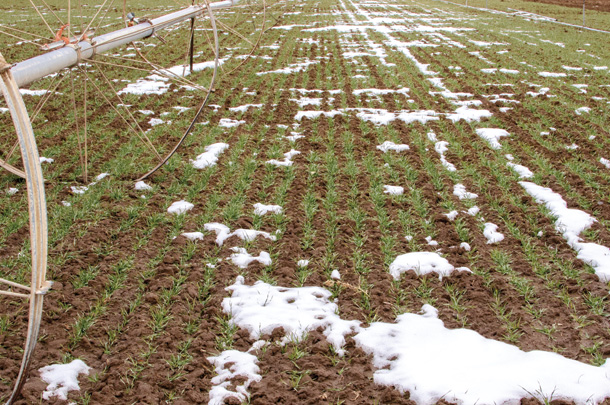 Photo by Mike Dixon.
Photo by Mike Dixon.
 Photo by Mike Dixon.
Photo by Mike Dixon.
Optimum winter forage has its own set of guidelines to create a successful feedstuff. Three keys to success are using a wide swath, tedder and high-quality inoculant on the silage.
Thomas Kilcer, certified crop adviser at Advance Ag Systems LLC, says winter forage is like cover crops on steroids. You get all the benefits of cover crops plus high-yielding, high-quality forage. This is becoming a standard practice on competitive, profitable, sustainable farms.
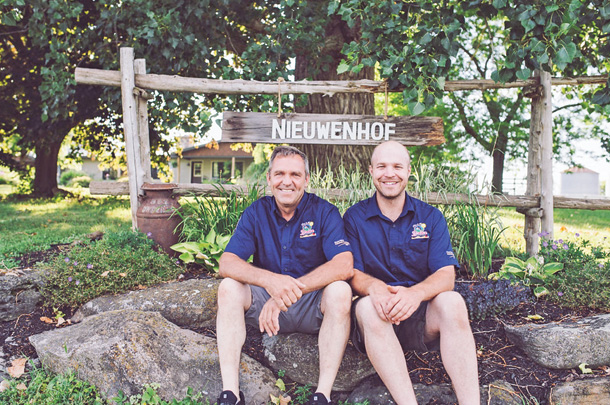 Justin and Benjamin Nieuwenhof, co-owners of Lareleve Holsteins. Photo courtesy of Lareleve Holsteins.
Justin and Benjamin Nieuwenhof, co-owners of Lareleve Holsteins. Photo courtesy of Lareleve Holsteins.12. Thinking outside the box: Nieuwenhof family doubled production in a decade
 Justin and Benjamin Nieuwenhof, co-owners of Lareleve Holsteins. Photo courtesy of Lareleve Holsteins.
Justin and Benjamin Nieuwenhof, co-owners of Lareleve Holsteins. Photo courtesy of Lareleve Holsteins.12. Thinking outside the box: Nieuwenhof family doubled production in a decade
Justin and Benjamin Nieuwenhof, the father and son team of Lareleve Holsteins (Ferme Nieuwenhof et associé inc.) located in Dundee, Quebec, milk 110 cows to produce a 218-kilogram quota. With an average production of 16,200 kilograms of milk (3.9% fat and 3.2% protein), their strategy to extend intervals between lactations has been fundamental to the farm’s progress within the dairy industry. The Nieuwenhofs’ linear lactation curve helps them adapt their way of doing things according to the animal’s potential while reducing risks – their techniques make it possible to ensure profitability and longevity. For example, their 6-year-old cow Lareleave Supersire 597 produced over 100,000 kilograms of milk in three lactations.
The Nieuwenhofs like to think out of the box and attribute their successes to unique ideas such as sharing employees and farm equipment with the neighbouring farm. The 2009 Master Breeder’s goal is to always want better results than the previous year.
Do you have any farm or production updates to share since the article printed this spring?
"Overall, this year we've had a few little hiccups, which will lead to a small decrease of the herd average for the year 2022. Things seems to be better now, so we are hopeful to be able to get back on track to break our 2021 production average.
"Since the article was printed, we’ve had some questions about our longer calving interval. The key aspect to be able to achieve this is lactation persistency. Cows need to maintain their peak production late in lactation and maintain a good body condition score. The cow Lareleve Kingboy 603 was able to reach a lifetime production of 105,000 kilograms in four lactations, and Lareleve Duke 670 is on pace to reach a lifetime production of 100,000 kilograms in three lactations.
"This year, we've made some changes to our 0-to-6-month heifer program. We are seeing a good increase in overall growth, so we hope to reduce age at first calving and achieve higher production down the road."
—Benjamin Nieuwenhof, dairy producer, Quebec
13. How much did you earn today?
Dr. Chris Church, DVM, took a look at income over feed costs as well as numerous other factors to determine how you track both significant and subtle changes on your dairy. Looking at such factors as forage quality, days in milk, overcrowding and more, Church asked dairy farmers to take a hard look at all the factors that go into a bottom line on a dairy. This article was followed up with another in a later issue in 2022.
What inspired you to write this article?
"We all love cows, and producers and veterinarians tend to keep our heads down and focus in the business of making cows better or more productive. But we rarely spend enough time working on our businesses. I love understanding the big picture and love teaching. These articles were an attempt to highlight that most Canadian dairies do not have a good way to measure profit. Milk per cow and purchased cost per tonne can be misleading under supply management."
Now that you have gone back to school to receive your MBA, do you aspire to assist dairy farmers with the economics of their business?
"Absolutely. There are lots of great veterinarians and nutritionists on the herd side and great accountants and bankers on the financial side, but I think there is a gap in the middle. Hopefully, I can help to connect some of the dots."
—Chris Church, DVM
14. 3 keys to optimizing your robotic dairy
While the title of the story notes three key factors, this article is full of basic information to observe when planning or managing a robotic dairy. Taking a closer look at factors outside of the robot can help optimize what is happening in the robot. Mechanical ventilation provides better air movement than natural ventilation. Adequate bunk space as well as comfortable stalls will decrease lameness. As always, nutrition management is a key factor in intake, milk production and times of day that a cow visits the robot.
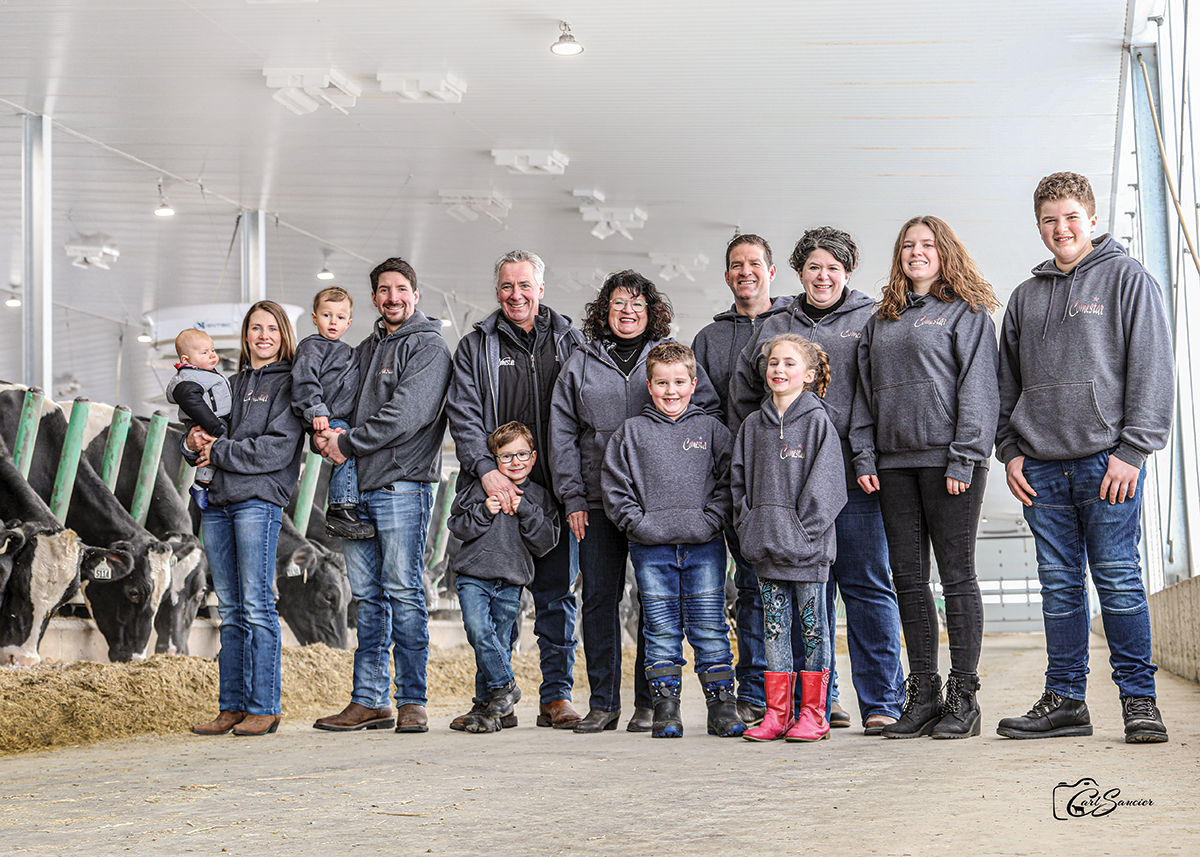 Foresight to the needs of the soon-to-be-of-age third generation of Comtois children involved at Comestar Holstein was a motivating factor in the farm’s decision to opt for a robotic milk system. Photo provided by Julie Comtois.
Foresight to the needs of the soon-to-be-of-age third generation of Comtois children involved at Comestar Holstein was a motivating factor in the farm’s decision to opt for a robotic milk system. Photo provided by Julie Comtois.
In 2020, Comestar Holstein in Victoriaville, Quebec, built a new 722-foot-long and 143-foot-wide facility to house their 365-cow milking herd. Steve Comtois, his sister Julie and her husband, Julien Turmel, took over managing the 1,049-head as their parents, Marc Comtois and France Lemieux, stepped back from day-to-day operations in 2013. Taking three years to research and plan the new build, the facility features six DeLaval V300 robots, deep sand bedding, a guided-flow pattern, hybrid ventilation (which uses both mechanical and natural ventilation tools, including cyclone fans), 14-foot sidewall curtains, roof air entry vents and two large fans at each end of the barn.
Updating to the latest milking and cow housing technologies (with herd health and cow comfort top of mind) has not impacted their breeding philosophy. The two-time Master Breeder herd continues to focus on logical and balanced breeding – raising cows with good conformation and strong milk production. They continue to cross cow lines, and decisions are made animal by animal.
The success of the farm’s transition to robotic milking is credited to not only the family’s ease of adaptability to change but also their decision to use a guided-flow cow traffic pattern. Gaining efficiencies – through increased access to cow data and labour savings, for example – allows the Comtois family to not only continue excelling with Holstein genetics but also in the books.
What’s new with Comestar Holstein since the article was published?
"The farm has had several visitors who are planning on building soon – they’ve come to observe and learn about our traffic guide system. Comestar Holstein is the first farm in Quebec to use this system with six robots.
"We’ve noticed that the longevity of the herd has increased since the transition to robots. Our focus on cow comfort in the new facility has been paying off, just as we had hoped.
"The family celebrated in October when Marc was inducted into the Agricultural Hall of Fame of Quebec.
"We are still restructuring our other buildings to improve animal comfort (since the beginning of construction of the facility), so next year we are looking forward to having more time."
—Steve Comtois, dairy producer, Quebec
